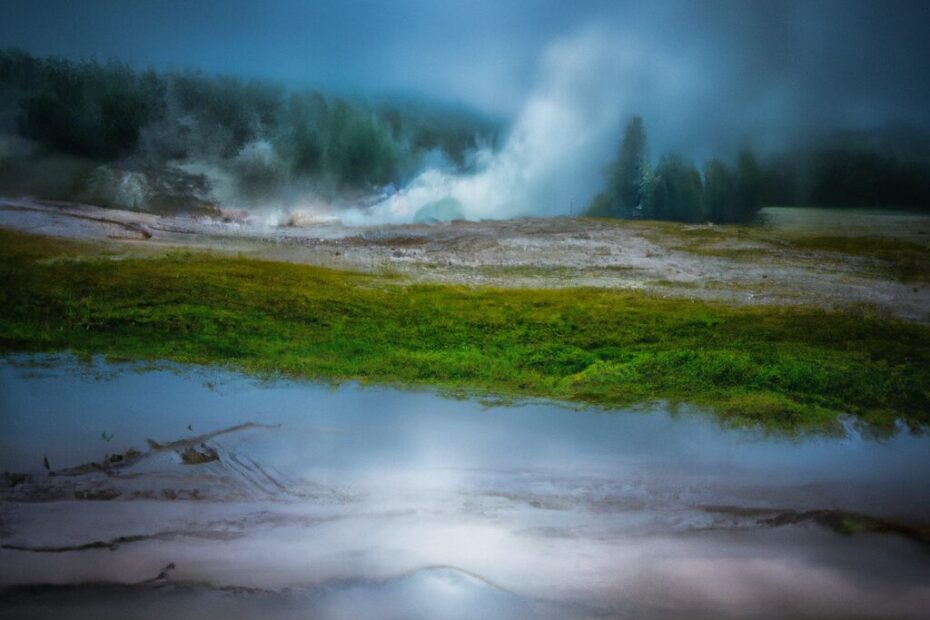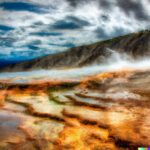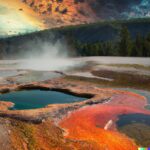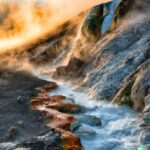Have you ever wondered how geysers are formed or where you can find some of the most famous geysers in the world? Look no further than the Upper Geyser Basin in Yellowstone National Park.
This article will take you on a journey to explore the history, formation, and main attractions of the geysers in this remarkable basin. From the iconic Old Faithful to the stunning Grand Geyser, we’ll also dive into the eruption schedules and other natural wonders you can experience in this unique and captivating location.
So, pack your bags and get ready to witness the magic of the Upper Geyser Basin!
What Are Geysers?
Geysers are natural wonders characterized by intermittent eruptions of hot water and steam, often accompanied by vibrant displays of geological formations and mineral deposits.
These hydrothermal features are intriguing examples of the Earth’s geothermal activity. Water heated by magma beneath the surface rises to create spectacular displays. The distinctive geological features associated with geysers, such as sinter terraces and silica deposits, add to their allure.
The interaction of water and rock creates unique mineral formations, reflecting the complex processes at work within the Earth’s crust. Geysers serve as captivating reminders of the powerful forces shaping the planet’s landscapes and the fascinating interplay between geology and hydrothermal activity.
Where Is the Upper Geyser Basin Located?
The Upper Geyser Basin is located within the renowned Yellowstone National Park in Wyoming, United States, and is celebrated for its captivating geysers, hot springs, and thermal features.
As visitors explore this remarkable area, they are immersed in a landscape shaped by powerful geological forces, with bubbling mud pots, colorful mineral deposits, and otherworldly steam vents.
The iconic Old Faithful, one of the most famous geysers in the world, regularly erupts with impressive displays, captivating onlookers with its soaring jets of water and steam. The boardwalks and trails throughout the basin offer opportunities to witness the dynamic and ever-changing thermal features, creating a truly unforgettable experience for nature enthusiasts and curious travelers alike.
What Is the History of the Upper Geyser Basin?
The history of the Upper Geyser Basin is intertwined with the geological evolution of the Yellowstone region, where the emergence of geysers, hot springs, and other thermal features has captivated visitors for centuries.
The Yellowstone National Park is a living testament to the immense geological forces at play beneath the Earth’s surface. The basin’s formation can be traced back to ancient volcanic activity, which created the unique hydrothermal conditions that exist today.
This area is a prime example of the stunning effects of hydrothermal activity, with vibrant, colorful mineral deposits and ever-changing geothermal features. Visitors are drawn to this natural wonderland, being mesmerized by the unpredictable eruptions of the legendary Old Faithful geyser and the intricate beauty of Morning Glory Pool.
How Are Geysers Formed?
Geysers are formed through a combination of geothermal heat, underground water sources, and specific geological conditions that create the ideal environment for the accumulation and release of boiling water, steam, and mineral-rich deposits.
Geysers are natural wonders that are often found in regions with high volcanic activity and tectonic movement. This is because the hydrothermal activity in these areas causes underground water to become heated by the Earth’s mantle. As the pressure from the heated water builds up over time, it eventually reaches a threshold and explosively erupts in the form of geysers.
The mineral-rich deposits left behind by these eruptions, such as silica, contribute to the gradual formation of the geyser cone. This process creates the mesmerizing and distinctive landscapes that geysers are known for, making them popular tourist attractions around the world.
What Are the Main Geysers in the Upper Geyser Basin?
The Upper Geyser Basin hosts a diverse array of notable geysers, including the iconic Old Faithful, Grand Geyser, Castle Geyser, Riverside Geyser, Daisy Geyser, and Beehive Geyser, each offering unique hydrothermal spectacles.
These geysers draw in visitors with their distinct characteristics. Old Faithful, known for its predictability, shoots boiling water up to 184 feet into the air. Grand Geyser, with its towering eruptions and intricate cascades, captivates onlookers. Castle Geyser impresses with its castle-like structure and prolonged eruptions. Riverside Geyser, located on the bank of the Firehole River, creates mesmerizing displays. Daisy Geyser‘s rhythmic eruptions and colorful mineral deposits are a delight to witness. Beehive Geyser, offering soaring eruptions and stunning vistas, adds to the fascinating diversity of the basin’s thermal features.
Old Faithful
Old Faithful, one of the most iconic geysers in Yellowstone, is renowned for its predictability and regular eruptions, captivating visitors with its impressive displays at consistent intervals.
Old Faithful is a highly anticipated natural spectacle, erupting every 60 to 110 minutes. This predictability allows park rangers to estimate the next eruption time, giving spectators a unique opportunity to witness this remarkable display of natural power.
The geyser’s towering arcs of boiling water and steam create an enthralling sight, drawing crowds year-round. It has established itself as a must-see attraction at Yellowstone National Park.
Grand Geyser
Grand Geyser stands as a majestic hydrothermal feature, captivating spectators with its impressive eruptions that are characterized by long-lasting displays and notable intervals between eruptions.
Its eruptions can reach up to a height of 150 feet, making it one of the tallest geysers in the world, and the accompanying sound adds to the awe-inspiring experience. The intervals between eruptions, typically lasting between 7 to 15 hours, create an air of anticipation that builds the excitement for visitors. Its enduring nature ensures that visitors have the opportunity to witness its stunning displays, adding to the allure of this remarkable natural wonder.
Castle Geyser
Castle Geyser’s distinct cone structure and scenic surroundings provide a captivating backdrop to its periodic eruptions, offering visitors a memorable glimpse of its hydrothermal activity.
The cone structure of Castle Geyser is particularly striking, rising elegantly above the surrounding landscape. Its mineral-rich waters create vivid colors on the cone’s surface, adding to the visual appeal.
Set against the backdrop of the picturesque Upper Geyser Basin in Yellowstone National Park, the eruptions of Castle Geyser are even more impressive. The rhythmic nature of its eruptions, which occur approximately every 10 to 12 hours, adds to the anticipation and excitement for those fortunate enough to witness this natural spectacle.
Riverside Geyser
Riverside Geyser’s picturesque location near the river, combined with its frequent and visually striking eruptions, offers visitors a captivating glimpse of its hydrothermal activity amid the serene natural surroundings.
The geyser is set against a backdrop of lush greenery and the flowing waters of the river, creating a mesmerizing spectacle for onlookers. The steam and water eruptions, which occur at regular intervals, add to the anticipation and excitement of experiencing this unique natural phenomenon.
The geyser’s close proximity to the river adds to its charm, making it a prominent feature of the Yellowstone National Park’s hydrothermal wonders. Visitors are often left in awe of the display as they witness the power and beauty of Riverside Geyser.
Daisy Geyser
Daisy Geyser, with its vibrant and colorful eruptions at regular intervals, offers a delightful spectacle despite its relatively smaller size compared to other notable geysers in the Upper Geyser Basin.
The vibrant displays of Daisy Geyser are a testament to the captivating hydrothermal activity within Yellowstone National Park. Its eruptions, though smaller in scale, are no less impressive, often reaching heights that allow the crystalline water to catch the sunlight and create breathtaking rainbows.
The unique charm of Daisy Geyser lies in its regularity, providing visitors with the opportunity to witness its mesmerizing shows without long waits. The geyser’s colorful displays, accompanied by the rhythmic gurgling and steaming, add to its allure, making it a must-see attraction in the basin.
Beehive Geyser
Beehive Geyser, characterized by its tall cone and powerful eruptions at notable intervals, captivates onlookers with its impressive hydrothermal displays and distinct geological features.
Visitors are drawn to the geyser’s stunning eruptions that can reach heights of 150 feet, making it one of the most powerful geysers in Yellowstone National Park. The combination of mineral-rich waters, vibrant colors, and bubbling pools creates a mesmerizing spectacle.
The geyser’s remarkable hydrothermal activity includes frequent surges of steam and water, adding to its mystique. As a result, Beehive Geyser stands as a testament to the dynamic forces shaping the Earth’s geology and continues to be a standout attraction for park visitors.
What Is the Eruption Schedule for the Main Geysers?
Understanding the eruption schedule and intervals of the main geysers in the Upper Geyser Basin provides visitors with valuable insights into the predictability of these hydrothermal spectacles, enhancing their overall experience while minimizing waiting times.
By knowing the estimated eruption times of iconic geysers such as Old Faithful, visitors can plan their itineraries more effectively, ensuring that they witness these natural wonders in all their glory.
Understanding the patterns of eruptions allows visitors to explore other areas of the park or enjoy nearby attractions, thereby maximizing the enjoyment of their visit. This predictability also presents an opportunity for educational experiences, as park rangers can schedule informative talks and guided tours around these anticipated events, enriching the overall visitor experience.
Old Faithful
Old Faithful’s well-documented eruption schedule and predictable intervals enable visitors to anticipate and witness its iconic displays with precise timing, enhancing their experience at the geyser.
This predictability is a testament to the geological wonders of Yellowstone National Park. As the geyser’s eruptions occur approximately every 60 to 110 minutes, visitors can plan their visit to coincide with these captivating displays.
The iconic status of Old Faithful is further reinforced by the excitement and buzz among the crowd as they eagerly await the powerful burst of hot water and steam. Such reliability has cemented Old Faithful as a must-see attraction, drawing visitors from all around the world to witness its hydrothermal spectacles.
Grand Geyser
Grand Geyser’s distinct eruption schedule and notable intervals contribute to the unique anticipation and waiting times experienced by visitors, adding to the allure of its hydrothermal spectacles.
Visitors eagerly engage in the waiting game at Grand Geyser, with eruptions occurring every 7 to 15 hours. The uncertainty adds suspense and excitement, making the eventual eruption all the more thrilling.
Those lucky enough to witness the spectacular display are treated to a breathtaking sight. The powerful bursts of hot water and steam create a mesmerizing natural spectacle, leaving a lasting impression on all who have the chance to experience it.
Castle Geyser
The periodic eruption schedule of Castle Geyser, combined with its scenic surroundings, offers visitors an engaging timing experience as they await the captivating hydrothermal displays within the Upper Geyser Basin.
Located in the heart of Yellowstone National Park, Castle Geyser’s eruptions are not only captivating but also occur predictably every 10 to 12 hours. This reliable schedule allows visitors to plan and anticipate the awe-inspiring spectacle, creating a sense of excitement and anticipation.
The surrounding landscape, featuring colorful mineral deposits and the imposing Castle Rock as a backdrop, adds to the immersive nature of the experience, making it a must-see attraction for nature enthusiasts and geology aficionados alike.
Riverside Geyser
Riverside Geyser’s eruption schedule and intervals, set against its picturesque riverside location, create memorable waiting times and experiences for visitors, adding to the charm of the hydrothermal spectacle.
The geyser’s eruptions occur approximately every 6-7 hours and can last for about 20 minutes, making the anticipation an exciting part of the visitor experience.
As visitors wait, they have the opportunity to admire the stunning surroundings, with the geyser positioned near the picturesque banks of the Firehole River, enhancing the natural splendor.
The rhythmic sounds of the bubbling water and the mesmerizing dance of steam add to the captivating nature of the hydrothermal displays, enveloping visitors in an immersive and enchanting experience.
Daisy Geyser
The predictable eruption schedule and intervals of Daisy Geyser, despite its relatively smaller size, create an atmosphere of vibrant anticipation among visitors as they await its colorful hydrothermal displays.
The geyser’s eruptions are known for their striking vibrancy, painting the surrounding landscape with brilliant hues as the hot water and steam shoot into the air. This phenomenon adds an element of intrigue to the scene, captivating onlookers with its mesmerizing beauty.
The unique attributes of Daisy Geyser lie not only in its eruption patterns but also in the contrast between its delicate appearance and the powerful natural forces that it unleashes. This juxtaposition adds to the allure, making each eruption a spectacle to behold.
Beehive Geyser
The timing and intervals of Beehive Geyser’s powerful eruptions, coupled with its remarkable height, contribute to an engaging spectacle that captivates visitors as they await its hydrothermal displays within the Upper Geyser Basin.
Visitors come prepared to witness the awe-inspiring natural phenomenon, often gathering around the geyser well before its eruptions. The anticipation builds as the geyser’s unique, cone-shaped structure adds to the excitement.
When the eruption occurs, it propels scalding water and steam to impressive heights, creating a mesmerizing display that leaves onlookers in awe of nature’s power. The eruptions and the subsequent steaming periods provide a thrilling experience for those who are fascinated by the marvels of geothermal activity.
What Other Attractions Can Be Found in the Upper Geyser Basin?
In addition to its mesmerizing geysers, the Upper Geyser Basin is home to an array of captivating attractions, including hot springs, fumaroles, paint pots, and vibrant bacteria mats, all contributing to its remarkable natural and geological allure.
These hot springs, with their stunning colors and steam rising from deep within the earth, create a truly enthralling sight. The fumaroles emit billowing clouds of steam and gas, offering a glimpse into the raw power of the geothermal activity.
The bubbling and gurgling paint pots add a unique touch to the landscape, while the vibrant bacteria mats paint a colorful, otherworldly picture. Together, these features form a captivating mosaic of the dynamic and diverse geological phenomena found in the area.
Hot Springs
The vibrant hot springs within the Upper Geyser Basin emanate a captivating blend of geothermal colors, mineral-rich pools, and natural beauty, offering visitors an immersive experience amidst the hydrothermal features.
The unique geological significance of these hot springs is characterized by the presence of silica-rich waters, which form intricate terraces and basins over time. Visitors can witness stunning mineral deposits, ranging from vibrant oranges and yellows to striking blues and greens, creating a feast for the eyes.
The steam rising from the pools adds an ethereal quality to the surroundings, enhancing the immersive nature of the experience. The hot springs evoke an otherworldly atmosphere, making them a must-see attraction for nature enthusiasts and geology aficionados alike.
Fumaroles
The fumaroles within the Upper Geyser Basin release billowing steam and hissing sounds, showcasing the dynamic hydrothermal activity and venting of geothermal energy in this captivating geological setting.
The fascinating characteristics of these fumaroles create a dramatic display of natural phenomena. The steam emissions, reminiscent of thick clouds, rise effortlessly into the air, forming an ethereal spectacle.
The hissing sounds, generated by the interaction of hot steam with the surrounding rocks, add an eerie yet mesmerizing aura to the surroundings. This dynamic interplay of elements provides a sensory experience that exemplifies the raw power and beauty of the Earth’s hydrothermal activity.
Paint Pots
The colorful paint pots of the Upper Geyser Basin present a mesmerizing sight, featuring bubbling clay and vibrant hues created by geothermal interactions, adding to the geological charm of the region.
The stunning visual appeal of the paint pots is enhanced by the intricate geological processes at play. As you explore the area, you’ll be struck by the dynamic display of colors, ranging from vivid yellows and oranges to deep reds and greens, all a result of the geothermal activity transforming the clay and minerals in the landscape.
The bubbling clay adds an element of mesmerizing motion, drawing visitors in to witness nature’s captivating artistry in action.
Bacteria Mats
The vibrant bacteria mats of the Upper Geyser Basin reveal a tapestry of microbial life and hydrothermal formations, adding a unique and captivating dimension to the geological and biological diversity of the region.
These colorful mats, thriving in the extreme conditions of hot springs, showcase a stunning array of microorganisms. Their brilliant hues, ranging from vivid pinks and oranges to vibrant greens and yellows, create a visually captivating display that highlights the resilience and adaptability of life in such harsh environments.
The hydrothermal influences contribute to the rich tapestry of geological formations, adding to the allure of this natural marvel.
What Is the Best Time to Visit the Upper Geyser Basin?
Determining the best time to visit the Upper Geyser Basin involves considering the seasons, weather conditions, and crowd levels to ensure an optimal experience amidst the region’s natural wonders and captivating Yellowstone landscapes.
Spring and fall are wonderful times to explore the basin, offering a balance between manageable crowd sizes and favorable weather. Spring brings vibrant wildflowers and newly awakened geysers, while fall displays stunning foliage and cooler temperatures.
Summer boasts longer days for exploration, but can also bring larger crowds. Winter unveils a serene, snow-covered wonderland, but access may be limited. No matter the season, strategic planning and flexibility can maximize your chances of experiencing the basin’s unique beauty away from the throngs of visitors.
Frequently Asked Questions
What are the most famous geysers in Yellowstone’s Upper Geyser Basin?
The most famous geysers in Yellowstone’s Upper Geyser Basin are Old Faithful, Grand Geyser, and Riverside Geyser.
How often does Old Faithful erupt?
Old Faithful erupts approximately every 90 minutes, give or take 10 minutes, making it one of the most predictable geysers in the world.
What causes the unique colors in some of the geysers?
The vibrant colors in some of the geysers are caused by thermophilic bacteria, which thrive in the hot and mineral-rich waters of Yellowstone’s geysers.
Can you swim in the geysers of Yellowstone?
No, it is not safe to swim in the geysers of Yellowstone’s Upper Geyser Basin. The water can reach temperatures of over 200 degrees Fahrenheit and can cause serious burns.
Are there any hiking trails near the geysers?
Yes, there are several hiking trails near the geysers in Yellowstone’s Upper Geyser Basin, including the popular Geyser Hill Loop and Observation Point Trail.
What is the best time of year to visit the geysers in Yellowstone?
The best time to visit the geysers in Yellowstone’s Upper Geyser Basin is during the summer months, from June to September, when the weather is mild and the geysers are most active. However, it is also the busiest time of year, so plan accordingly.
Last Updated on January 25, 2024 by Jon Waraas – Originally Posted: January 25, 2024

I’m Jon Waraas, and I’ve been navigating the online world since 2006. By day, I’m the proud owner of some eCommerce gems, and by night, I’m the voice behind the adventures on Waraas.Com.
My heart, however, belongs to the wild beauty of Yellowstone National Park. I’ve got a collection of websites dedicated to sharing the wonders of this natural masterpiece. Oh, and did I mention? I’m currently building my own cabin inside the ghost town of Gilmore, Idaho – a cabin with tales to tell!
When I’m not immersed in the digital realm, you’ll find me lacing up my boots for a good hike or setting up camp under the star-studded sky.




